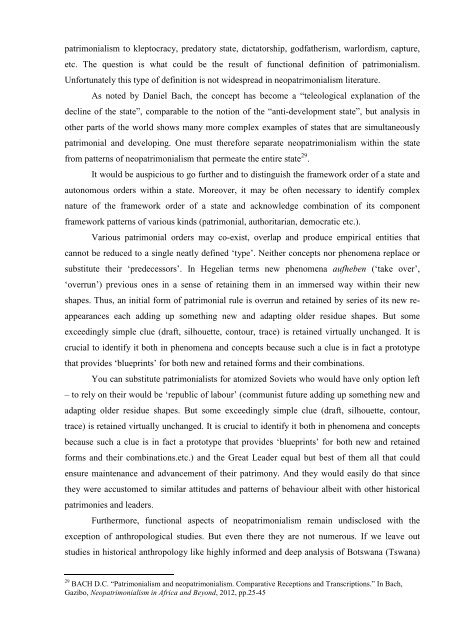Ilyin patrimonialism rediscriptions
Ilyin patrimonialism rediscriptions
Ilyin patrimonialism rediscriptions
You also want an ePaper? Increase the reach of your titles
YUMPU automatically turns print PDFs into web optimized ePapers that Google loves.
<strong>patrimonialism</strong> to kleptocracy, predatory state, dictatorship, godfatherism, warlordism, capture,<br />
etc. The question is what could be the result of functional definition of <strong>patrimonialism</strong>.<br />
Unfortunately this type of definition is not widespread in neo<strong>patrimonialism</strong> literature.<br />
As noted by Daniel Bach, the concept has become a “teleological explanation of the<br />
decline of the state”, comparable to the notion of the “anti-development state”, but analysis in<br />
other parts of the world shows many more complex examples of states that are simultaneously<br />
patrimonial and developing. One must therefore separate neo<strong>patrimonialism</strong> within the state<br />
from patterns of neo<strong>patrimonialism</strong> that permeate the entire state 29 .<br />
It would be auspicious to go further and to distinguish the framework order of a state and<br />
autonomous orders within a state. Moreover, it may be often necessary to identify complex<br />
nature of the framework order of a state and acknowledge combination of its component<br />
framework patterns of various kinds (patrimonial, authoritarian, democratic etc.).<br />
Various patrimonial orders may co-exist, overlap and produce empirical entities that<br />
cannot be reduced to a single neatly defined ‘type’. Neither concepts nor phenomena replace or<br />
substitute their ‘predecessors’. In Hegelian terms new phenomena aufheben (‘take over’,<br />
‘overrun’) previous ones in a sense of retaining them in an immersed way within their new<br />
shapes. Thus, an initial form of patrimonial rule is overrun and retained by series of its new reappearances<br />
each adding up something new and adapting older residue shapes. But some<br />
exceedingly simple clue (draft, silhouette, contour, trace) is retained virtually unchanged. It is<br />
crucial to identify it both in phenomena and concepts because such a clue is in fact a prototype<br />
that provides ‘blueprints’ for both new and retained forms and their combinations.<br />
You can substitute patrimonialists for atomized Soviets who would have only option left<br />
– to rely on their would be ‘republic of labour’ (communist future adding up something new and<br />
adapting older residue shapes. But some exceedingly simple clue (draft, silhouette, contour,<br />
trace) is retained virtually unchanged. It is crucial to identify it both in phenomena and concepts<br />
because such a clue is in fact a prototype that provides ‘blueprints’ for both new and retained<br />
forms and their combinations.etc.) and the Great Leader equal but best of them all that could<br />
ensure maintenance and advancement of their patrimony. And they would easily do that since<br />
they were accustomed to similar attitudes and patterns of behaviour albeit with other historical<br />
patrimonies and leaders.<br />
Furthermore, functional aspects of neo<strong>patrimonialism</strong> remain undisclosed with the<br />
exception of anthropological studies. But even there they are not numerous. If we leave out<br />
studies in historical anthropology like highly informed and deep analysis of Botswana (Tswana)<br />
29 BACH D.C. “Patrimonialism and neo<strong>patrimonialism</strong>. Comparative Receptions and Transcriptions.” In Bach,<br />
Gazibo, Neo<strong>patrimonialism</strong> in Africa and Beyond, 2012, pp.25-45
















